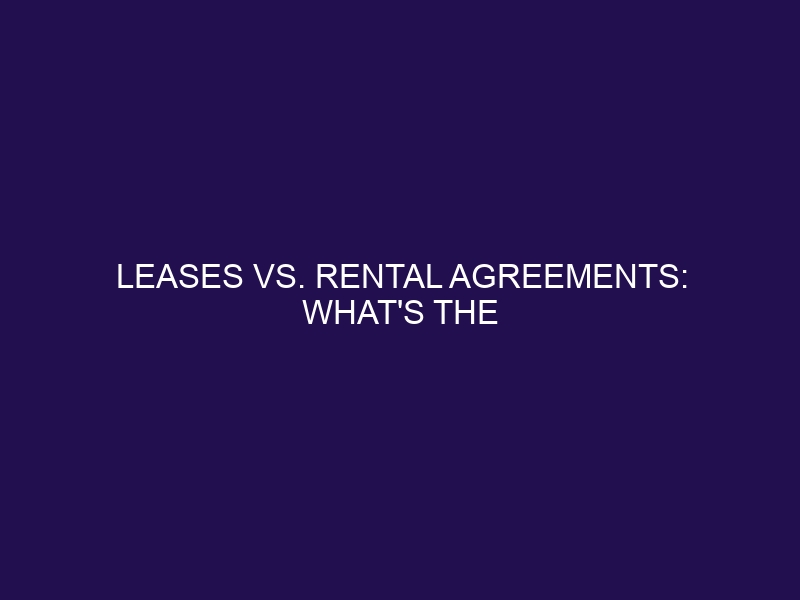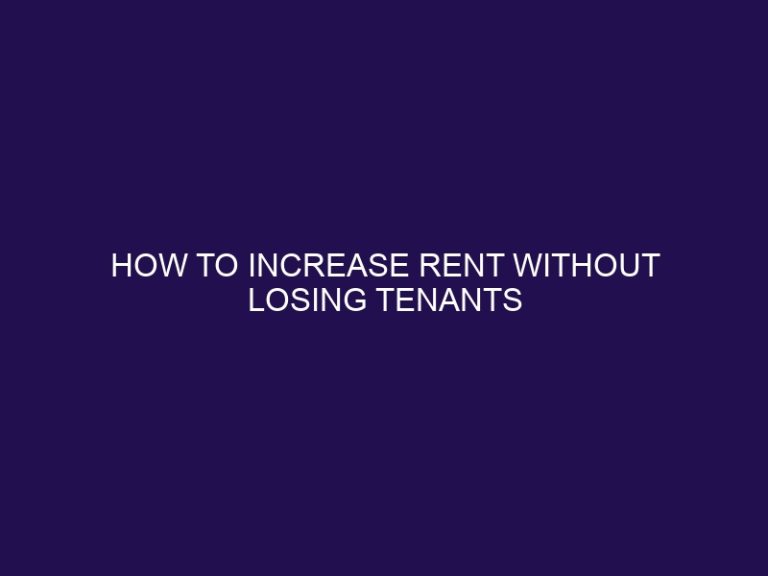Leases vs. Rental Agreements: What’s the Difference?
When searching for a place to live, you may come across the terms “lease” and “rental agreement.” While they are often used interchangeably, there are distinct differences between the two. Understanding these differences can help you make an informed decision when signing a contract with a landlord.
A lease is a legally binding contract between a landlord and tenant for a specific period, typically 6-12 months. It outlines the terms and conditions of the agreement, including rent amount, length of lease, and responsibilities of both parties. A lease provides more stability and security for both the landlord and tenant.
On the other hand, a rental agreement is a shorter and less formal contract, usually on a month-to-month basis. It can be oral or written and does not offer the same level of protection and stability as a lease. However, it offers more flexibility for both parties.
The key elements of a lease include:
- Names of the landlord and tenant
- Rent amount and due date
- Lease term
- Security deposit
- Any additional terms and conditions
A rental agreement typically includes the same elements, but the terms may vary or be less specific.
The main differences between a lease and a rental agreement are:
- Length of Contract: A lease is for a specified period, while a rental agreement is usually month-to-month.
- Renewal and Termination: A lease requires a set termination date and may include a renewal option, while a rental agreement can be terminated with a shorter notice period.
- Payment Structure: A lease may require a fixed monthly rent, while a rental agreement may allow for rent increases with proper notice.
- Responsibility for Maintenance and Repairs: A lease typically places more responsibility on the landlord for maintenance and repairs, while a rental agreement may require the tenant to cover some costs.
- Flexibility and Restrictions: A lease offers more stability, while a rental agreement allows for more flexibility in terms of moving out or making changes to the contract.
When deciding between a lease and a rental agreement, it is important to consider factors such as your budget, length of stay, and flexibility needs. It is also crucial to understand the legal implications of each contract, including rights and responsibilities of both parties, the eviction process, and dispute resolution.
In conclusion, a lease and a rental agreement offer different levels of protection and flexibility. It is essential to carefully review the terms and conditions of each before signing to ensure you make the best decision for your living situation. It is also advisable to seek legal advice if you have any doubts or concerns.
Key Takeaways:
1. Leases are typically longer-term contracts (1+ years) and provide more stability for both landlords and tenants.
2. Rental agreements are shorter-term contracts (typically month-to-month) and offer more flexibility for both parties.
3. The key differences between leases and rental agreements include contract length, renewal and termination, payment structure, maintenance responsibilities, and flexibility.
What Is a Lease?
A lease is a legally binding contract between a landlord and tenant, outlining the terms and conditions for renting a property. This agreement specifies the duration of the rental, the amount of rent, and the responsibilities of both parties. It offers tenants security and stability in their housing arrangements, while providing landlords with a reliable source of income. Leases are the preferred option for long-term housing arrangements.
What Are the Key Elements of a Lease?
The key elements of a lease include:
- The names of the parties involved.
- A description of the property.
- The duration of the lease.
- The rental amount.
- Payment terms.
- Conditions for termination.
- It also specifies maintenance responsibilities and any restrictions.
For example, my friend discovered a great apartment but later realized that the lease had strict policies regarding pets.
What Is a Rental Agreement?
A rental agreement is a legally binding contract that outlines the terms and conditions for renting a property. It clearly defines the responsibilities of both the landlord and the tenant, including details such as the rent amount, duration of the agreement, and maintenance responsibilities.
My friend once entered into a rental agreement for a comfortable apartment located in the heart of the city.
What Are the Key Elements of a Rental Agreement?
What Are the Key Elements of a Rental Agreement?
- Duration of the rental
- Rent amount
- Security deposit
- Terms of occupancy
It also outlines rules for maintenance, repairs, and pet policies.
What Are the Differences Between a Lease and a Rental Agreement?
When it comes to renting a property, there are two common types of agreements: leases and rental agreements. While both involve a tenant paying for the use of a property owned by a landlord, there are distinct differences between the two. In this section, we will explore the various factors that differentiate a lease from a rental agreement. From the length of the contract to the responsibilities of both parties, we will breakdown the key distinctions between these two types of agreements.
1. Length of Contract
- Define the length of the contract, whether it’s a fixed term or month-to-month agreement.
- Specify the start and end dates of the contract.
- Include provisions for early termination or renewal of the contract.
In the early 1900s, lease agreements typically had longer terms, often spanning 3 to 5 years, reflecting the stability and long-term commitment prevalent in society at that time.
2. Renewal and Termination
- Review the lease or rental agreement for clauses related to renewal and termination.
- Understand the notice period required for termination and renewal options.
- Communicate with the landlord or property management to discuss terms for renewal or termination.
- Seek legal advice if unsure about clauses for renewal or termination.
3. Payment Structure
- Understand the frequency and mode of payment for the payment structure.
- Clarify any additional charges or late fees associated with the payment structure.
- Discuss security deposit requirements for the payment structure.
- Document payment terms in the lease or rental agreement for the payment structure.
When considering the payment structure, it’s crucial to thoroughly review the terms and negotiate any ambiguities beforehand.
4. Responsibility for Maintenance and Repairs
- Make sure to fully comprehend the lease terms regarding maintenance and repairs.
- Promptly report any issues to the landlord or property management.
- Adhere to maintenance responsibilities as stated in the lease agreement.
Did you know? Tenants are usually accountable for minor maintenance tasks in a rental property.
5. Flexibility and Restrictions
- Flexibility: Leases provide stability with fixed terms, while rental agreements offer short-term flexibility.
- Restrictions: Leases often have stricter rules and limitations, while rental agreements may allow for more informal arrangements.
Which is Best for Me: a Lease or a Rental Agreement?
As a tenant, choosing between a lease and a rental agreement can be a daunting task. Both options have their own set of advantages and disadvantages, making it important to carefully consider which one will best suit your needs. In this section, we will discuss the various factors that should be taken into account when deciding between a lease and a rental agreement. By understanding the differences between the two, you can make an informed decision and find the best option for your specific situation.
Factors to Consider When Choosing Between a Lease and a Rental Agreement
- Duration: When deciding between a lease and a rental agreement, it is important to consider the length of stay and whether a long-term commitment or short-term flexibility is desired.
- Financials: Upfront costs, monthly payments, and potential rent increases should all be taken into account when making a decision between a lease and a rental agreement.
- Responsibilities: It is important to assess maintenance duties and the level of freedom for property modifications when choosing between a lease and a rental agreement.
Pro-tip: Before signing, carefully review the lease or rental agreement to avoid any potential disputes in the future.
What Are the Legal Implications of a Lease and a Rental Agreement?
When renting a property, the legal agreement between the landlord and tenant can take two forms: a lease or a rental agreement. Each has its own set of legal implications that both parties should be aware of. In this section, we will discuss the rights and responsibilities of both the landlord and tenant under these agreements. We will also touch upon the eviction process and how it differs between a lease and a rental agreement. Understanding these legal implications is crucial for a smooth and fair rental experience.
1. Rights and Responsibilities of Landlord and Tenant
- It is crucial for a harmonious leasing experience to understand the 1. rights and responsibilities of both the landlord and tenant.
- Document: These rights and responsibilities should be clearly outlined in the lease or rental agreement.
- Maintenance: It should be specified in the agreement who is responsible for maintenance and repairs.
- Communication: Clear channels of communication should be established for addressing any concerns.
2. Eviction Process
-
Serve Notice: Landlord provides written notice to tenant, citing reasons for eviction.
-
File Eviction: If tenant doesn’t comply, landlord files eviction with the court.
-
Court Hearing: Both parties present their case in front of a judge for the eviction process.
-
Eviction Order: If ruled in favor of the landlord, tenant must vacate the property.
Frequently Asked Questions
What is the difference between a lease and a rental agreement?
A lease is a legal document outlining the responsibilities of both the landlord and tenant for a given length of time, typically 12 months or more. A rental agreement, on the other hand, is a month-to-month contract that automatically renews each month upon agreement of both parties.
What are the pros and cons of a 1-year lease versus a month-to-month agreement?
A 1-year lease provides stability for both landlords and tenants, but it also means that the terms and rent cannot be changed during that period. A month-to-month agreement offers more flexibility, but landlords may have to deal with more frequent tenant turnover.
Can a landlord break a lease during the term period?
No, a lease contract is legally binding for the given length of time. However, if there are specific reasons for breaking the lease, such as a family emergency, a landlord may be able to negotiate with the tenant or seek legal counsel.
What is the difference in notice procedures for a rental agreement versus a lease?
For a rental agreement, a landlord must give a 30-day notice to quit before requesting the tenant to leave the property. For a lease, the tenant must vacate the property or enter into a new agreement at the end of the lease term.
What are the key differences in terms of utility costs for a lease versus a rental agreement?
In a lease agreement, the tenant is responsible for all utility costs. In a rental agreement, utility costs may be negotiated between the landlord and tenant.
What is the difference between a long-term lease and a short-term rental agreement?
A long-term lease typically lasts for a fixed period of time, usually 12 months or more, while a short-term rental agreement is month-to-month or for a set number of months. A long-term lease offers more stability for both parties, while a short-term rental agreement is more flexible.







